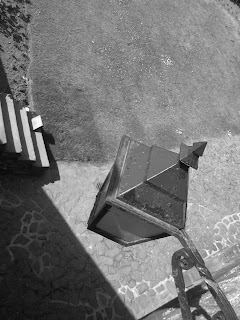I was inspired by Rodchenko’s use of almost extreme angles, especially in his Fire Escape (1925). The camera shooting from almost directly below the subject and person in this photograph parallels with the first photograph in my series. Both of the people are made into universal figures by having the bright sky behind them cause them to almost silhouette while they both use manmade objects to keep themselves from falling. Although this one was not done on purpose, my photograph containing the two male waiters shares similarities with Rodchenko’s At Myasnitskie Gate (1932). In both urban settings the eye is drawn to the two men wearing white shirts but then is blocked by on object to the right. Even though both photographs have lamps in them Rodchecko uses his as a block while mine is not. Opposites occur in comparing these photographs; Rodchecko chose to use more tilt than I did, but I chose to shoot from a higher elevation to my subject matter.
The large difference between photographing New Objectivity today and when it first started is that in the 1920s photographers were intrigued by new taller buildings and the ability to shoot a subject from above that could never be done before. Now if we were going to be taking photos from the highest height we could we would be getting a photograph of Earth from space. Nevertheless things do not have to be taken to their extremes so just altering the angle or tilt of a shot a little bit brings back feeling of the New Objectivity movement, and that movement is what this series of photographs is truly all about.


Bibliography
Auckland Art Gallery. "Bauhaus Photography: An Educational Resource." Auckland Art Gallery. Web. 23 June 2010.
Jeffrey, Ian. "Looking to the Future." Photography a Concise History. London: Thames and Hudson, 1981. Print.
Rodchenko, Alexander. At Myasnitskie Gate. 1932. Photograph. Moscow House of Photography. Web. 23 June 2010.
Rodchenko, Alexander. Fire-escape. 1925. Photograph. Moscow House of Photography. 2001. Web. 23 June 2010.



No comments:
Post a Comment